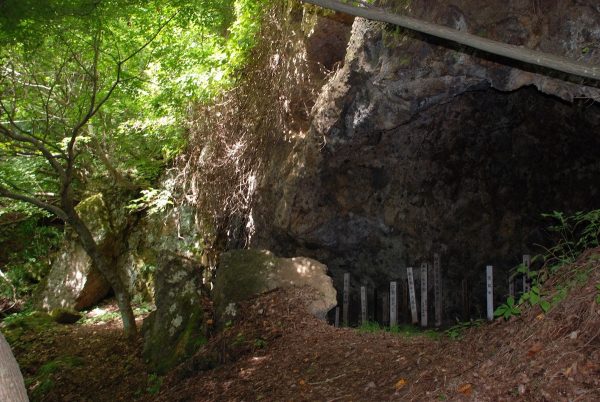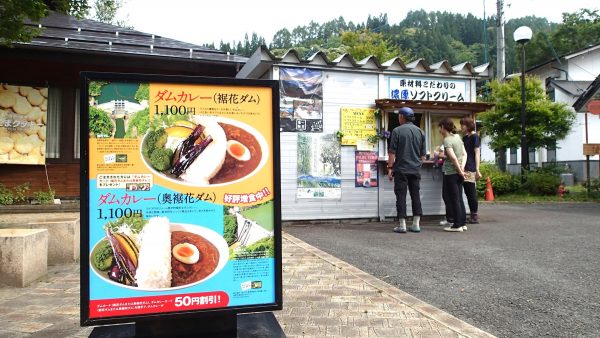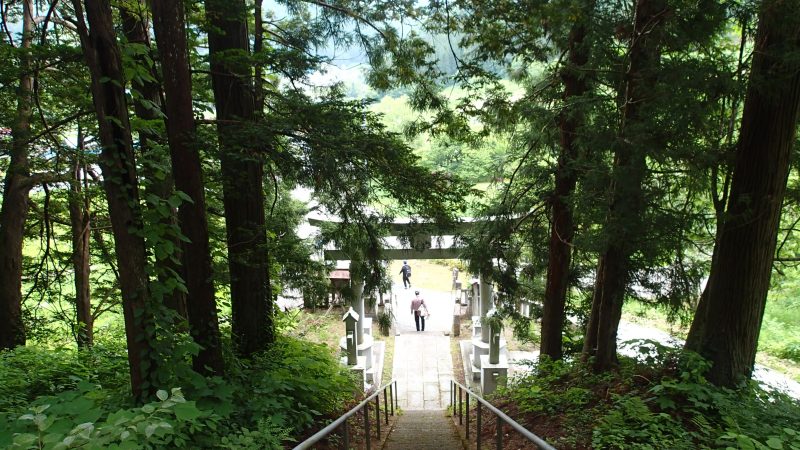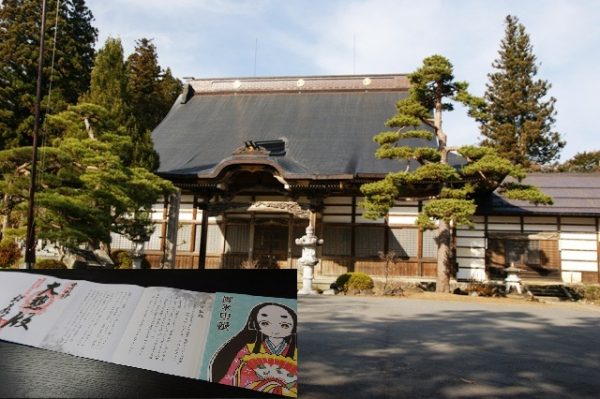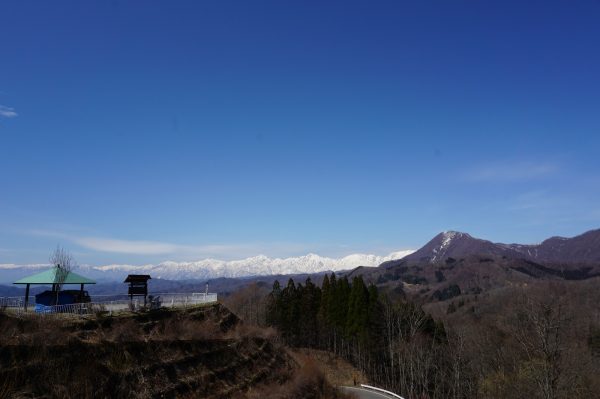Kinasa is a very large area and shares its border with Togakushi in Nagano City, Hakuba Village, Otari Village, Ogawa Village, and Myoko City in Niigata Prefecture. It takes roughly 90 minutes by car from the Daibo mountain pass observation point to the skunk cabbage colonies at Okususobana Nature Park. It can be a short journey by car, but it can also be a fun day trip.
We propose the following themed model courses that combine driving and walking or a bus and walking.
Thanks to Vegetarian’s Japan Guide for introducing Kinasa.
Kinasa – A Village Filled with Myths and Amazing Nature (visitjapan-vegetarian.com)

driving+walking
When you arrive in Kinasa, start here –
Car day trip version
Required time 5 – 6 hours roundtrip from Nagano Station
At the Kinasa Furusato Museum, we recommend learning about the wooden festival float with the name of a master craftsman from the Edo period carved into it and hearing about the legend of Kijo-Momiji. After eating lunch at a local restaurant, visit the highlights on the footpath courses, and finally take in the panoramic view from Daibo mountain pass.
Nagano Station
It takes about 40 minutes by car from Nagano station (JR) to Kinasa.
Kinasa Folk Museum
This museum provides a comprehensive overview of the history, culture and nature of Kinasa. The festival floats built in the Edo period are worth seeing.
Lunch at Tabi no Eki Kinasa
There are local restaurants and an oyaki shop in the area around Tabi-no-eki Kinasa adjacent to the Folk Museum. There is also an udon lunch served in an old Japanese style inn and a bakery café 5-10 minutes’ drive away (please check with each restaurant for hours of operation).
Onsen, Accomodation, Dining, Shop
Shirahige Shrine
This is a stopover point on the footpath “Shirahige no Mori” course. Park your car in front of Shirahige Shrine and take a walk around the area.
Kamo Shrine
Another stopover point on the “Tani no Miyako (City of the Valley)” footpath course. The surrounding area has the same name as the town in the former capital Kyoto, which is said to have been named by Momiji who missed the capital.
Shoganji Temple
This is another stopover point on the “Kinasa no Machikado (Town of Kinasa)” footpath course. Visit Kijo-Momiji’s grave. The beautiful paintings on the main hall ceiling are worth seeing.
Daibo Mountain Pass
15-20 minutes from the roadside rest area, Tabi-no-eki Kinasa. Take Route 36 in the direction of Togakushi, and you will reach a lookout with a full-scale panoramic view.
If you cross the pass, you can get through to Togakushi shrine.
Nagano Station
bus+walking
Kinasa at glance – Bus day trip version
Required time 7 hours roundtrip from Nagano Station
You can also take a day trip on the Shinkansen departing from Tokyo Station at 9:00 a.m.
This is a day trip course that starts by taking the shinkansen (bullet train) from Tokyo Station at 9 a.m. From Nagano Station, take the bus to Kinasa while leisurely enjoying the scenery along the Susobana River. Once you arrive, fill your belly with something delicious to eat, and then head to the Kinasa Furusato Museum to learn about the history of the land where mammoths once roamed and see the wooden festival float with the name of a master craftsman from the Edo period carved into it. You can also hear the many legends of the area. Finally, visit Shoganji Temple and pay your respects at the grave of Kijo-Momiji, get an amulet for safe travel, and then board the bus that will take you back to Nagano Station.
Nagano Station
From Nagano Station (Zenkoji exit), please take bus number 74 (destination Kinasa) from bus stop no.7.
The bus to Togakushi also departs from the same stop. Please be careful not to board the wrong bus.
If you take the bus near Zenkoji temple, take the bus from “Hana no Koji” bus stop on the approach to the temple.
https://www.alpico.co.jp/traffic/local/nagano/kinasa/
Lunch time
There are a couple of restaurants and an oyaki shop in the area around the Tabi no Eki Kinasa adjacent to the Kinasa Folk Museum.
https://kinasa.jp/shop/
Kinasa Folk Museum
This museum provides a comprehensive overview of the history, culture and nature of Kinasa. The festival floats built in the Edo period are worth seeing.
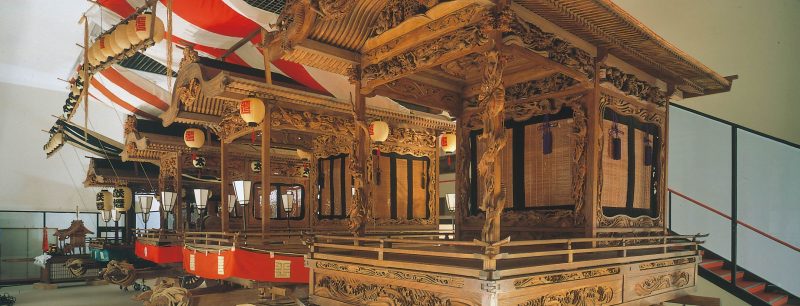
Footpath walking
There are two footpath courses that start from Tabi-no-eki Kinasa.
Footpaths | Kinasa – City of the Valley
A: Kinasa no Machikado Course (Town of Kinasa Course)
The area near the intersection with the only traffic light in Kinasa used to be the commercial center of Kinasa in the 1930s, lined with movie theaters, restaurants, barbershops, and other businesses. Let’s take a walk with the footpath map in hand, which contains illustrations of the town as it used to be.
B: Shirahige-no-mori Course (Grove of Shirahige shrine Course)
Climb up the side path of the terraced rice paddies, draw a fortune at the Shirahige Shrine, and then walk across the bridge in front of the shrine to the old community path “Taru no Komichi” (if the fortune doesn’t come out right, shake the box gently).
Shoganji Temple
Don’t miss the grave of Kijo-Momiji and the splendid ceiling paintings in the main hall of the temple! There is also a foot and leg health charm. Why not get one for your travels? The Goshuin book (the red seal book) available here with Kijo-Momiji on the cover is unique to Shoganji temple.
Nagano Station
Reccomended schedule according to the bus timetable.
11:33 From Nagano Station (Zenkoji exit), please take bus number 74 (destination Kinasa) from bus stop no.7. It takes about 60 minutes to the last stop Kinasa. *Note: The bus to Togakushi also departs from the same stop. Please be careful not to board the wrong bus.
If you are near Zenkoji Temple, please take the bus from the “Hana no koji” bus stop.
12:34 After arriving at Tabi-no-eki Kinasa (the end of the bus route), let’s have lunch at a cafe or restaurant nearby.
13:10 Kinasa Folk Museum
14:10 Footpath walking
Stroll around Kinasa’s footpath course.
15:40 Visit Kijo-Momiji’s grave at Shoganji temple. It’s a nice idea to get a good luck charm for healthy feet and legs as a memory.
16:10 Please take the bus to Nagano station from the Shoganji temple bus stop.
17:12 Arrive at Nagano Station
Themed journey
Follow Kijo-Momiji‘s footprint
The tour will start at the site of Dairiyashiki, the former residence of ‘Kijo Momiji,’ a beautiful woman who has been said to have been exiled from the capital of Kyoto due to her sorcery in making the emperor’s rightful wife sick. After walking through the village where place names commemorating the capital Kyoto, visit the museum to see the picture scroll of the legend of “Kijo Momiji,” and then visit Momiji’s grave. The tour will be complete when you visit the places in Togakushi area linked to Momiji.
The site of Dairiyashiki
This place is said to have been the residence of Kijo-Momiji. Nearby, remains the name of a place related to the Yakabushi, soldiers who guarded the place. From here, start your journey with a footpath map of the Tani-no-Miyako Course (City of the Valley Course) in hand.

Footpath -Tani-no-Miyako Course (City of the Valley Course)
Visit the two villages of Higashikyo and Nishikyo, which are said to have been named by Momiji commemorating the capital of Kyoto. The scenery and the names of the places such as Nijo, Sanjo, Kamo, and Kasuga will create and image for you of the days when Momiji lived.
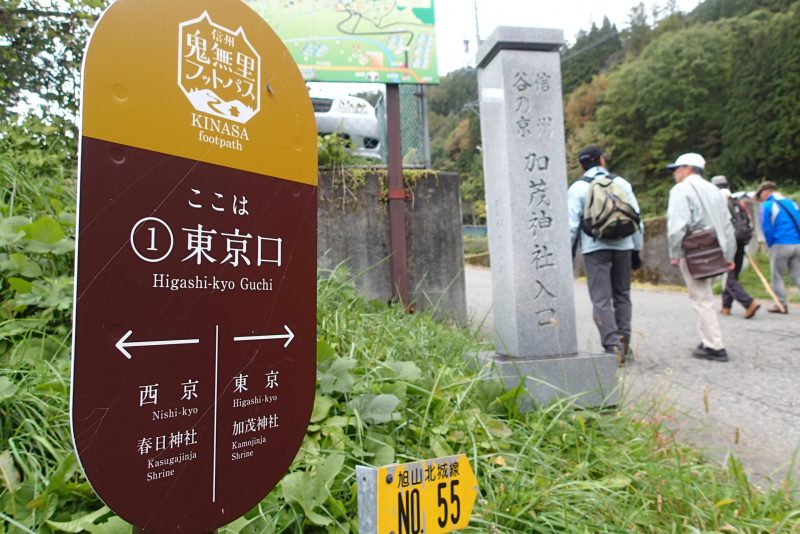
Shirahige Shrine
It is said that General Taira-no-Koremochi stopped by the shrine when he conquered Kijo-Momiji. The main shrine, built around the Momoyama period (1573-1600), retains its Muromachi period style and is a nationally designated important cultural property. The shrine is also a stopover point on the footpath Shirahige-no-Mori Course. Park your car in front of Shirahige Shrine and stroll around the area with a map in hand.
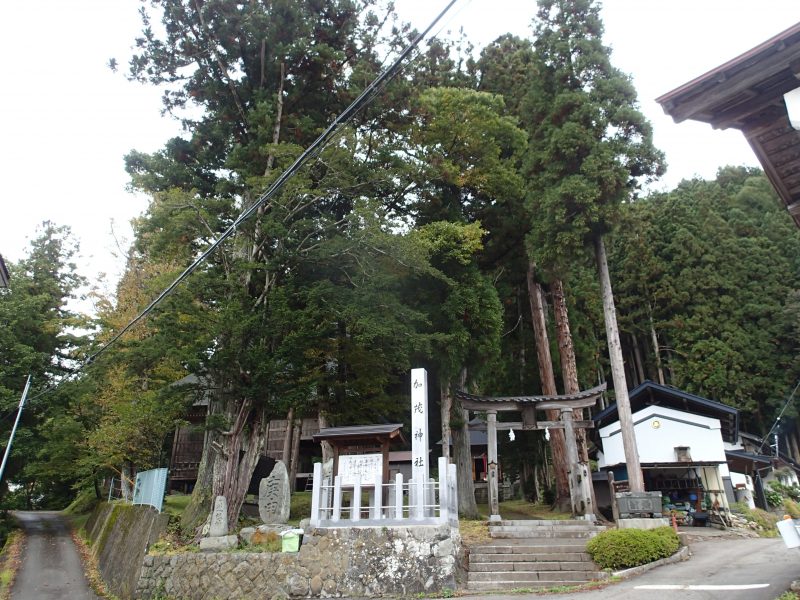
Kinasa Folk Museum
There is an exhibit featuring the Kijo-Momiji emaki (Kijo Momiji picture scroll). If you are lucky, you may be able to hear stories of Kijo-Momiji not written in the guide (unfortunately, they are usually in Japanese only).
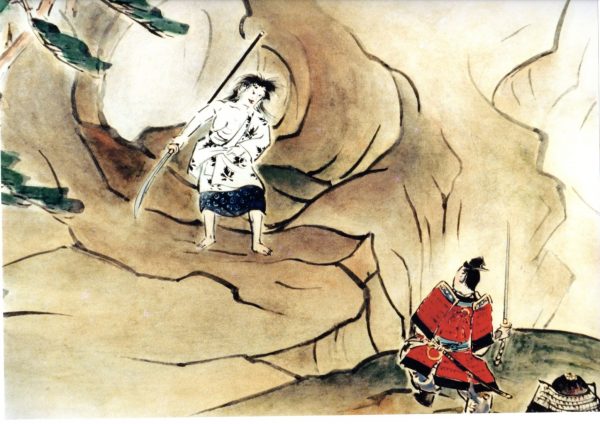
Shoganji Temple
It is said that the origin of this temple dates back to the Heian period (794-1185) when Jizoin Temple was built as a memorial for Kijo-Momiji, who was killed by General Taira-no-Koremochi. Pay your respects at the grave of Momiji and look for the literary monument of Nobel Prize-winning author Yasunari Kawabata, who visited Kinasa, attracted by the legend of Momiji. It is also interesting to hear the story of Kijo-Momiji told by the chief priest. If you are collecting Goshuin, a limited-edition Goshuin book with an illustration of Kijo-Momiji on the cover will make a good souvenir.
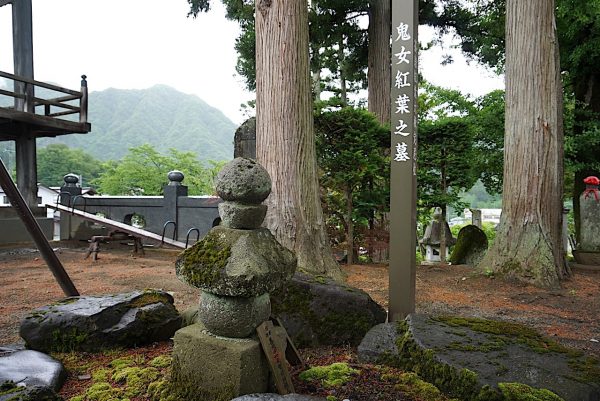
Kinasa Shrine
It is said that General Taira-no-Koremochi prayed for the defeat of Kijo-Momiji. It is also a stopover point on the Kinasa-no-Machikado footpath course (Town of Kinasa course).

From here, let’s leave Kinasa and trace Momiji’s footprints in the Togakushi area, where the legend of Momiji is still told.
Oni-no-tsuka (Barrow of the demon)
Following in the footsteps of Momiji, we will leave Kinasa and go to the Togakushi area. The Oni-no-tsuka Five-Ringed Pagoda in the Shigaki district of Togakushi Tochihara is said to be where General Taira-no-Koremochi, who defeated Momiji, buried her head.
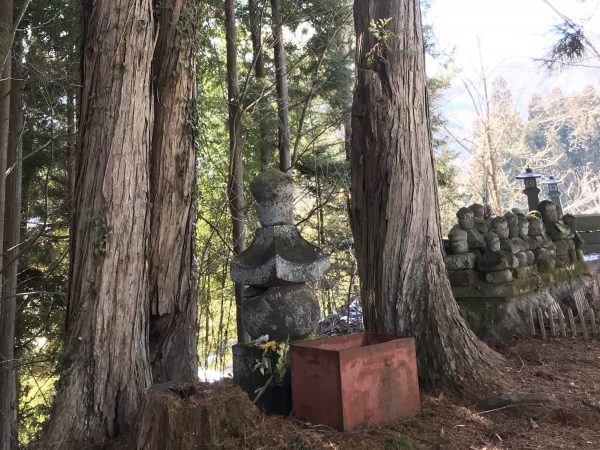
Daishoji Temple
Driving up the hill from Oni-no-tsuka for about five minutes, you will arrive at Daishoji Temple, a temple associated with Momiji. There is a hanging scroll of Momiji-gari, a Noh play and song performance, as well as spirit tablets enshrining General Taira-no-Koremochi and Momiji together.
The Togakushi Museum of Natural History, located nearby, is also a recommended spot.
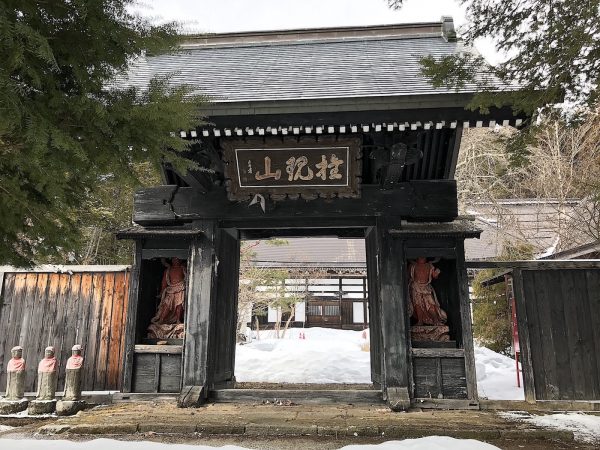
Momiji-no-Iwaya (Momiji’s cave)
Momiji-no-Iwaya, also known as Oni-no-Iwaya, is said to be where Momiji hid herself before she was killed. From Daishoji Temple, first head toward Arakura Campground. Check the signboard at the campground for the route to Momiji-no-Iwaya.
